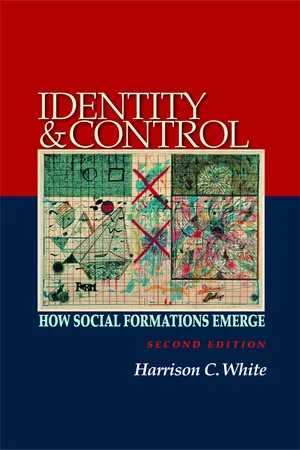
- 456 pages
- English
- PDF
- Available on iOS & Android
About this book
In this completely revised edition of one of the foundational texts of network sociology, Harrison White refines and enlarges his groundbreaking theory of how social structure and culture emerge from the chaos and uncertainty of social life. Incorporating new contributions from a group of young sociologists and many fascinating and novel case studies, Identity and Control is the only major book of social theory that links social structure with the lived experience of individuals, providing a rich perspective on the kinds of social formations that develop in the process. Going beyond traditional sociological dichotomies such as agency/structure, individual/society, or micro/macro, Identity and Control presents a toolbox of concepts that will be useful to a wide range of social scientists, as well as those working in public policy, management, or associational life and, beyond, to any reader who is interested in understanding the dynamics of social life.
Frequently asked questions
- Essential is ideal for learners and professionals who enjoy exploring a wide range of subjects. Access the Essential Library with 800,000+ trusted titles and best-sellers across business, personal growth, and the humanities. Includes unlimited reading time and Standard Read Aloud voice.
- Complete: Perfect for advanced learners and researchers needing full, unrestricted access. Unlock 1.4M+ books across hundreds of subjects, including academic and specialized titles. The Complete Plan also includes advanced features like Premium Read Aloud and Research Assistant.
Please note we cannot support devices running on iOS 13 and Android 7 or earlier. Learn more about using the app.
Information
Table of contents
- Cover
- DETAILED CONTENTS
- ACKNOWLEDGMENTS
- PROLOGUE: Preview of Themes
- ONE: Identities Seek Control
- TWO: Networks and Stories
- THREE: Three Disciplines
- FOUR: Styles
- FIVE: Institutions and Rhetorics
- SIX: Regimes of Control
- SEVEN: Getting Action
- EIGHT: Overview and Contexts
- REFERENCES
- INDEX